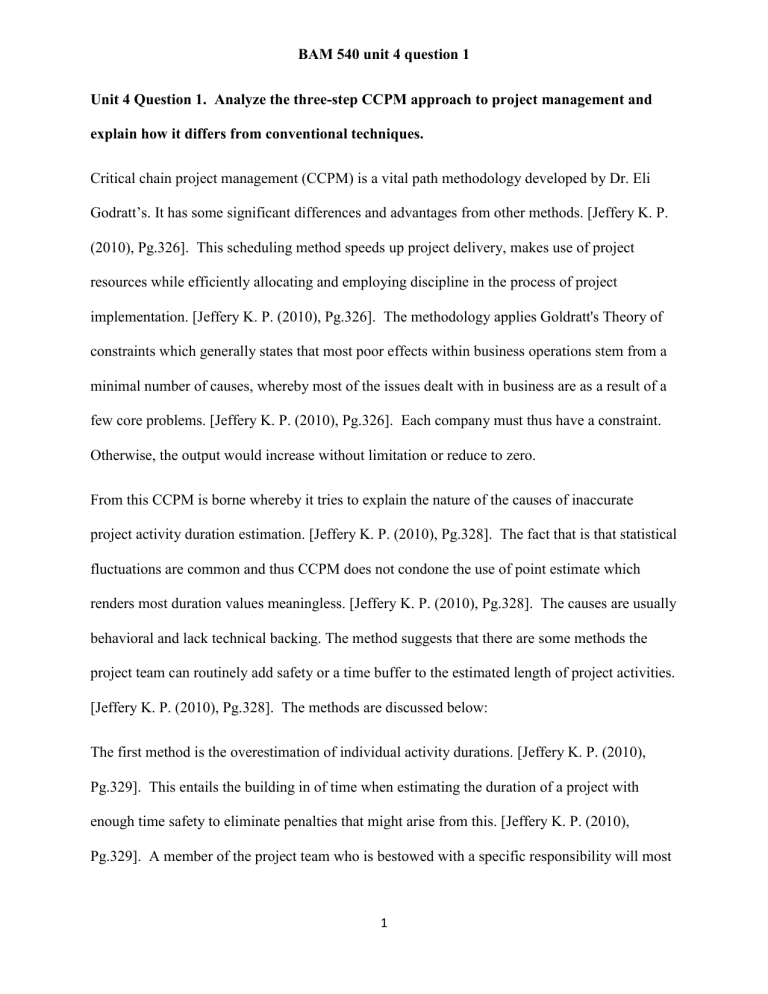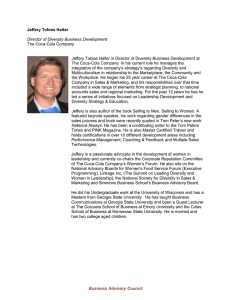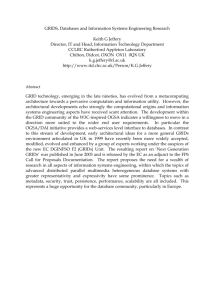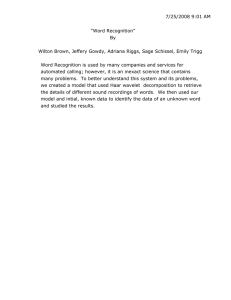
BAM 540 unit 4 question 1
Unit 4 Question 1. Analyze the three-step CCPM approach to project management and
explain how it differs from conventional techniques.
Critical chain project management (CCPM) is a vital path methodology developed by Dr. Eli
Godratt’s. It has some significant differences and advantages from other methods. [Jeffery K. P.
(2010), Pg.326]. This scheduling method speeds up project delivery, makes use of project
resources while efficiently allocating and employing discipline in the process of project
implementation. [Jeffery K. P. (2010), Pg.326]. The methodology applies Goldratt's Theory of
constraints which generally states that most poor effects within business operations stem from a
minimal number of causes, whereby most of the issues dealt with in business are as a result of a
few core problems. [Jeffery K. P. (2010), Pg.326]. Each company must thus have a constraint.
Otherwise, the output would increase without limitation or reduce to zero.
From this CCPM is borne whereby it tries to explain the nature of the causes of inaccurate
project activity duration estimation. [Jeffery K. P. (2010), Pg.328]. The fact that is that statistical
fluctuations are common and thus CCPM does not condone the use of point estimate which
renders most duration values meaningless. [Jeffery K. P. (2010), Pg.328]. The causes are usually
behavioral and lack technical backing. The method suggests that there are some methods the
project team can routinely add safety or a time buffer to the estimated length of project activities.
[Jeffery K. P. (2010), Pg.328]. The methods are discussed below:
The first method is the overestimation of individual activity durations. [Jeffery K. P. (2010),
Pg.329]. This entails the building in of time when estimating the duration of a project with
enough time safety to eliminate penalties that might arise from this. [Jeffery K. P. (2010),
Pg.329]. A member of the project team who is bestowed with a specific responsibility will most
1
BAM 540 unit 4 question 1
likely be given enough time to build reasonable confidence and thus delivering the job in record
time. [Jeffery K. P. (2010), Pg.329].
The second method is the project manager safety margin. [Jeffery K. P. (2010), Pg.329]. When
each team member has made their estimates of activity duration while factoring enough safety,
the project manager is left with the task of aggregating the estimates into an overall project
estimate. [Jeffery K. P. (2010), Pg.329]. This also allows for the project managers to factor in
their safety just as their team members. This entails adding margins at the aggregate project
level.
The third method is anticipating expected cuts from top management. [Jeffery K. P. (2010),
Pg.329]. This method entails the endorsement of aggressive schedules by the senior
management who have a bearing on the decision making. [Jeffery K. P. (2010), Pg.329]. The
administration most often discards the estimate schedules and decide it’s too long and thus
demand for significant time cuts. [Jeffery K. P. (2010), Pg.329]. The case usually that that top
management will insist on cutting time durations by a minimum of twenty percent while the
project teams will increase their estimates by a minimum of twenty-five percent. ´
The difference between CCPM and other critical techniques is remarkably visible. The network
schedules such as PERT and probability time estimates are dependent on resource availability.
[Jeffery K. P. (2010), Pg.326]. The workability of the estimates critically depends on the
resource availability which defines precisely the right time the resources must be available for
the project estimates to be accurate. [Jeffery K. P. (2010), Pg.326]. The early start schedules
make the project managers very aware of the importance of protecting their schedule slack
during the project. [Jeffery K. P. (2010), Pg.326]. The managers are often preparing for
2
BAM 540 unit 4 question 1
problems, while carefully monitoring their resources availability while guarding their project
slack time.
The critical chain doesn’t have the same path as the critical path within the active network. The
critical path depends only upon task dependency where the link between tasks and their
predecessors is made. [Jeffery K. P. (2010), Pg.337]. In this method activity slacking is usually
discovered after the fact, after the network is laid out and the critical path is identified. The other
trails and activities may contain some level of slack. [Jeffery K. P. (2010), Pg.337]. On the other
hand, the critical chain usually jumps task dependency links usually because the critical chain
requires that all resource leveling before the critical chain is identified and not afterward like the
case of PERT and CPM networks. [Jeffery K. P. (2010), Pg.337].
In conclusion, CCPM is more vital and active than other critical path methods. This is usually the
case especially when the project teams require to identify slack times while eliminating the need
for resource dependency.
Reference
1. Jeffery K. P. (2010), Project Management, Second Edition, Pearson Prentice Hall, ISBN13:9780136065616.
3



